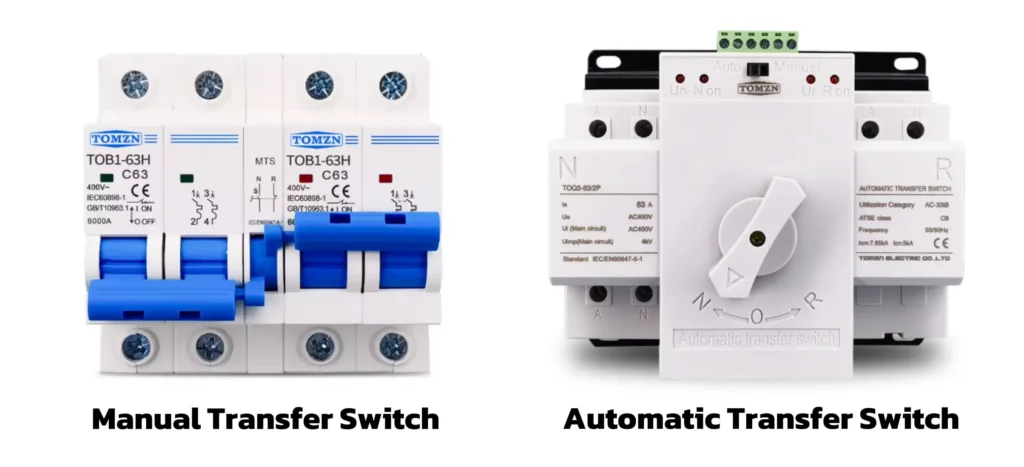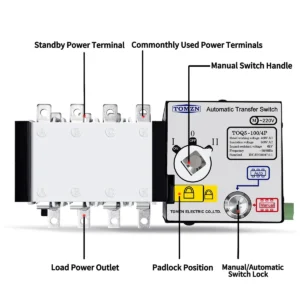When the power goes out, many people roll out their portable generator or count on a standby system to keep the essentials running. But here’s the real question: do you really need a transfer switch? If you want your generator setup to be safe, compliant with codes, and reliable in the long run, the answer is almost always certain.
What Is Transfer Switches?
A transfer switch is a device that connects your home or business electrical system to a backup power source like a generator. Its purpose is simple but critical: it ensures power flows only in the right direction and never back into the utility lines.
Without one, you’re stuck running multiple extension cords through windows or doors. This isn’t just messy—it’s unsafe and impractical if you need to power appliances like a furnace, well pump, or central AC.
Think of the transfer switch as the “traffic controller” for electricity, directing power to the right destination and preventing head-on collisions between utility power and generator output.
How Does An Transfer Switch Work?
In the significant phase—monitoring, the switch continuously checks whether utility power is available.
The second phase is transfer functionality. If the utility power fails, the switch transfers the power load to the generator. Using automatic mode, this transfer occurs without any action required.
Finally, there’s restoration functionality. When the grid returns, the switch safely transfers the load back to its original location and disconnects the generator.

The different of Manual and Automatic Transfer Switch
Not all transfer switches are the same. They come in different types, each suited for different needs:
- Manual Transfer Switches
- Require you to physically flip the switch during an outage.
- More affordable than automatic models.
- Ideal for homeowners who don’t mind being present to operate the system.
- Require you to physically flip the switch during an outage.
- Automatic Transfer Switches (ATS)
- Detect outages and switch power automatically.
- The go-to option for standby generators.
- Best for critical loads like medical devices, security systems, or server rooms.
- Detect outages and switch power automatically.
Scenarios Where It’s Clearly Needed
Transfer switches aren’t just for large facilities; also they’re essential in everyday situations:
- Whole-House Backup Generators—Required by electrical codes in many areas, such as elevators, surveillance systems, and fire protection—are required.
- Hard-Wired Appliances—Sump pumps, furnaces, water heaters, and central air conditioners cannot be powered by electrical wiring.
- Frequent or Long Power Outages—In storm-prone areas, transfer switches can eliminate the clutter of wires and ensure the operation of essential systems.
- Critical Equipment—Homes with oxygen concentrators, aquariums, or refrigerated pharmaceuticals cannot afford to lose power.
Advantages of Using a Transfer Switch
Installing a transfer switch offers clear and measurable benefits:
- Safety – Eliminates the risk of backfeeding, which can endanger utility workers repairing lines.
- Convenience – Circuits are powered directly, so no more juggling cords through the house.
- Compliance – Meets NEC (National Electrical Code) requirements and prevents insurance disputes after outages.
- Efficiency – Lets you prioritize loads, powering essentials like the fridge and furnace while skipping non-critical appliances.
- Speed – With an ATS, power comes back in seconds, not minutes.
Disadvantages or Considerations
Transfer switches are not perfect, and buyers should weigh the trade-offs:
Cost – Expect to spend several hundred dollars for manual models and over a thousand for ATS systems, plus installation.
Installation – A licensed electrician is almost always required, which adds to the bill.
Sizing – Choosing the wrong switch capacity can limit what you can power or, worse, overload your system.
Overkill for tiny setups – If you’re only running a single lamp or charging devices, a transfer switch might be unnecessary.
Still, it’s absolutely essential for a safe, compliant, and reliable backup power system. It’s a critical component in protecting utility workers, your home, and your family, while ensuring your power is seamlessly restored. Stop using dangerous extension cords and risking a backfeed incident. The ultimate solution for your peace of mind is our responsibility.


